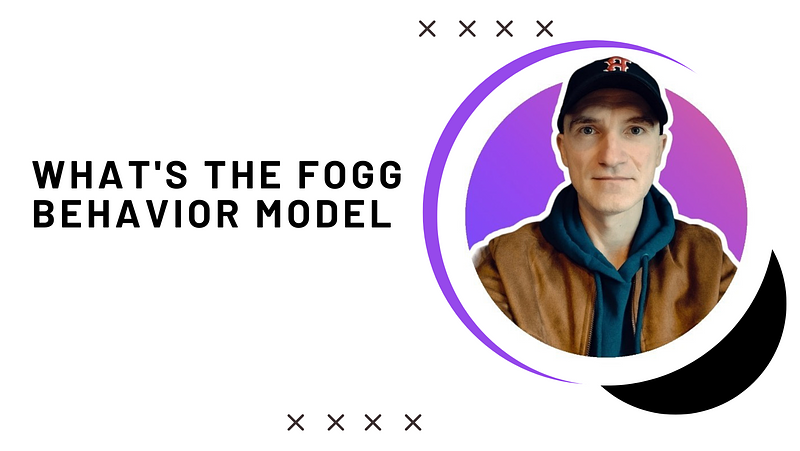
Why every startup founder and product owner has to know the Fogg Behavior Model?
Hey! My name's Andriy Kravets. I've been working in and with Product, Marketing and Sales global teams for a decade, wearing almost every hat you can possibly imagine.
Since last year I've spent countless hours studying and applying Behavioral Economics, Social Psychology and Behavioral Science in general. Some time ago I've started a dedicated Behavioral Science Channel. And today I'd like to introduce you to the Fogg Behavior Model. One of my favorites.
What's the Fogg Behavior Model?
One of the most used Behavior Change models in corporate environment, at least in my opinion, is the Fogg Behavior Model (FBM).
According to the model, behavior is a product of three factors: motivation, ability, and triggers (prompts). Therefore, FBM is represented by the following formula:
B = MAP,
where
- M is motivation
- A is ability
- P is prompt or trigger
It leads us to the conclusion that a given behavior will occur when motivation, ability, and a trigger are present at the same time and in sufficient degrees.

FBM Subcomponents
It's important to mention that Fogg defines subcomponents of motivation and ability, as well as types of triggers.
Motivation could be influenced by the following types of motivators:
- Seeking pleasure and avoiding pain
- Seeking hope and avoiding fear
- Seeking social acceptance and avoiding rejection.
Fogg describes six elements of simplicity, the factors that influence behavior's difficulty and hence our ability:
- Time
- Money
- Physical effort
- Brain cycles (thinking deeply or thinking in new ways can be difficult)
- Social deviance
- Non-routine
Finally, FBM includes 3 types of triggers:
- Spark (when a person lacks motivation to perform a target behavior)
- Facilitator (when a person have high motivation but lacks ability)
- Signal (works best when people have both the ability and the motivation to perform the target behavior)
Motivation vs Ability: What to Choose?
As you may see from the chart, we may cause target behavior either by increasing motivation or ability. So what to choose? I'll take the liberty and quote Nir Eyal:
"𝘛𝘩𝘦 𝘧𝘢𝘤𝘵 𝘪𝘴, 𝘪𝘯𝘤𝘳𝘦𝘢𝘴𝘪𝘯𝘨 𝘮𝘰𝘵𝘪𝘷𝘢𝘵𝘪𝘰𝘯 𝘪𝘴 𝘦𝘹𝘱𝘦𝘯𝘴𝘪𝘷𝘦 𝘢𝘯𝘥 𝘵𝘪𝘮𝘦 𝘤𝘰𝘯𝘴𝘶𝘮𝘪𝘯𝘨. 𝘞𝘦𝘣 𝘴𝘪𝘵𝘦 𝘷𝘪𝘴𝘪𝘵𝘰𝘳𝘴 𝘵𝘦𝘯𝘥 𝘵𝘰 𝘪𝘨𝘯𝘰𝘳𝘦 𝘪𝘯𝘴𝘵𝘳𝘶𝘤𝘵𝘪𝘰𝘯𝘢𝘭 𝘵𝘦𝘹𝘵; 𝘵𝘩𝘦𝘺 𝘢𝘳𝘦 𝘰𝘧𝘵𝘦𝘯 𝘮𝘶𝘭𝘵𝘪𝘵𝘢𝘴𝘬𝘪𝘯𝘨 𝘢𝘯𝘥 𝘩𝘢𝘷𝘦 𝘭𝘪𝘵𝘵𝘭𝘦 𝘱𝘢𝘵𝘪𝘦𝘯𝘤𝘦 𝘧𝘰𝘳 𝘦𝘹𝘱𝘭𝘢𝘯𝘢𝘵𝘪𝘰𝘯𝘴 𝘢𝘣𝘰𝘶𝘵 𝘸𝘩𝘺 𝘰𝘳 𝘩𝘰𝘸 𝘵𝘩𝘦𝘺 𝘴𝘩𝘰𝘶𝘭𝘥 𝘥𝘰 𝘴𝘰𝘮𝘦𝘵𝘩𝘪𝘯𝘨. 𝘐𝘯𝘧𝘭𝘶𝘦𝘯𝘤𝘪𝘯𝘨 𝘣𝘦𝘩𝘢𝘷𝘪𝘰𝘳 𝘣𝘺 𝘳𝘦𝘥𝘶𝘤𝘪𝘯𝘨 𝘵𝘩𝘦 𝘦𝘧𝘧𝘰𝘳𝘵 𝘳𝘦𝘲𝘶𝘪𝘳𝘦𝘥 𝘵𝘰 𝘱𝘦𝘳𝘧𝘰𝘳𝘮 𝘢𝘯 𝘢𝘤𝘵𝘪𝘰𝘯 𝘪𝘴 𝘮𝘰𝘳𝘦 𝘦𝘧𝘧𝘦𝘤𝘵𝘪𝘷𝘦 𝘵𝘩𝘢𝘯 𝘪𝘯𝘤𝘳𝘦𝘢𝘴𝘪𝘯𝘨 𝘴𝘰𝘮𝘦𝘰𝘯𝘦’𝘴 𝘥𝘦𝘴𝘪𝘳𝘦 𝘵𝘰 𝘥𝘰 𝘪𝘵. 𝘔𝘢𝘬𝘦 𝘺𝘰𝘶𝘳 𝘱𝘳𝘰𝘥𝘶𝘤𝘵 𝘴𝘰 𝘴𝘪𝘮𝘱𝘭𝘦 𝘵𝘩𝘢𝘵 𝘶𝘴𝘦𝘳𝘴 𝘢𝘭𝘳𝘦𝘢𝘥𝘺 𝘬𝘯𝘰𝘸 𝘩𝘰𝘸 𝘵𝘰 𝘶𝘴𝘦 𝘪𝘵, 𝘢𝘯𝘥 𝘺𝘰𝘶’𝘷𝘦 𝘨𝘰𝘵 𝘢 𝘸𝘪𝘯𝘯𝘦𝘳."
So answering the question in the title, every startup founder and product owner has to know the Fogg Behavior Model because it's one of the top models used in startups and corporate environment and one of the proven to be successful. What other reasons one may need?


